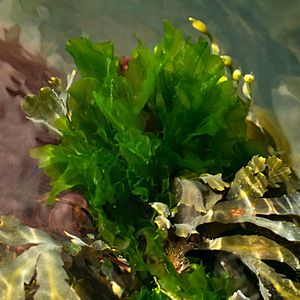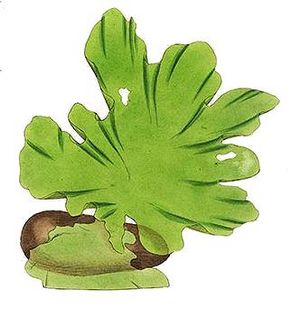Ulva lactuca facts for kids
Quick facts for kids Ulva lactuca |
|
|---|---|
 |
|
| Ulva lactuca in Brofjorden, Sweden | |
 |
|
| Illustration of Ulva lactuca in English Botany (Sowerby, 1790-1814) | |
| Scientific classification | |
| Genus: |
Ulva
|
| Species: |
lactuca
|
Ulva lactuca, often called sea lettuce, is a type of green algae. It is an edible plant that grows in the ocean. This algae belongs to the Ulvaceae family. It is the main example for its group, the Ulva genus. Sometimes, it is also called U. fenestrata because it can look like it has "windows" or "holes."
Contents
What Sea Lettuce Looks Like
Ulva lactuca is a thin, flat, green algae. It attaches to rocks or other algae using a small, disc-shaped part called a holdfast. The edges of the sea lettuce often look wavy or torn. It can grow up to 18 centimeters (about 7 inches) long and 30 centimeters (about 12 inches) wide.
This algae is made of two layers of cells. These cells are arranged in a way that looks a bit messy when you see them up close. Sea lettuce is usually green to dark green. Its cells have a special part called a chloroplast. This part helps the algae make its own food using sunlight, just like plants do. There are other types of Ulva that look very similar, so it can be tricky to tell them apart.
Where Sea Lettuce Lives
You can find Ulva lactuca all over the world! It grows in many places, including Europe, North and South America, Africa, and Australia. It also lives on islands in the Indian and Pacific Oceans.
How Sea Lettuce Grows and Its Environment
Ulva lactuca is very common on rocks and other algae. It likes to grow in areas along the coast where the water is shallow. This includes the littoral zone (the area between high and low tide) and the sublittoral zone (just below the low tide mark).
Sea lettuce grows especially well where there are lots of nutrients in the water. Sometimes, too many nutrients, like those from farm fertilizers, can wash into the sea. When this happens, huge amounts of Ulva lactuca can grow. Large piles of this algae can wash up on beaches. As it breaks down, it can release gases. These gases can smell bad and are not good to breathe in large amounts.
For example, in some parts of France, a lot of sea lettuce has washed ashore. This is because of high levels of nitrates from farming. Environmental groups say that too much fertilizer and animal waste are causing this problem.
How Sea Lettuce Reproduces
Sea lettuce has an interesting way of reproducing. The adult plant makes tiny swimming cells called zoospores. These zoospores settle down and grow into new, smaller plants. These smaller plants then release special cells called gametes. When a male gamete and a female gamete join together, they form a new cell called a zygote. This zygote then grows into a new adult sea lettuce plant, starting the cycle all over again.
How People Use Sea Lettuce
People use Ulva lactuca in different ways around the world.
- In Scotland, it is sometimes used in soups and salads.
- In Hawaiʻi, Ulva lactuca is called limu pālahala. People eat it mixed with other algae, or salted with raw fish. It can also be boiled into a soup or served with chili pepper, onions, soy sauce, and sugar.
- Besides food, Hawaiians also use Ulva lactuca as a natural fertilizer for plants. They also use it to decorate for hula dances, where it is called limu pāpahapaha.
See also
 In Spanish: Lamilla (alga) para niños
In Spanish: Lamilla (alga) para niños

